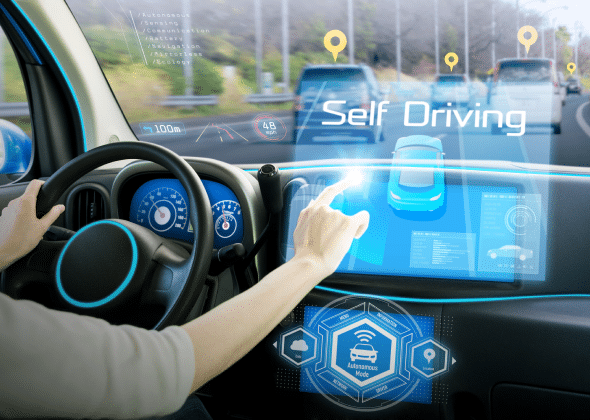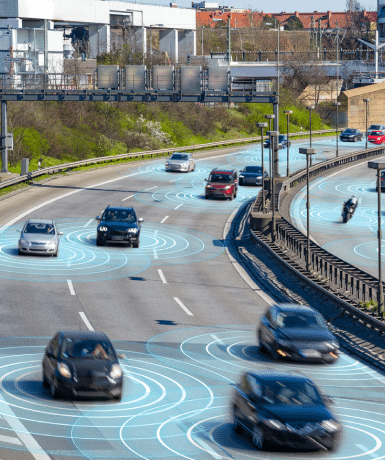Self-Driving Car Statistics
Self-driving or autonomous vehicles use cutting-edge technology to handle the operation and maneuvering of a car with little to no manual guidance from a driver. Although these advanced driving systems are designed to help drivers avoid hazards on the road and are becoming safer, the technology is not perfect. Autonomous vehicles are still involved in car crashes that result in injuries and property damage. The car accident lawyers at NST Law share key statistics on self-driving cars.

The advanced driving systems in autonomous vehicles have come a long way. Many people already trust driver-assist technology to alert them of dangers on the road, avoid a collision by applying brakes or steering, and assist with parallel parking. With fully autonomous vehicles in development, it’s only a matter of time before it’s commonplace to see technology that fully operates and maneuvers cars without any guidance from a driver.
While autonomous vehicles have the potential to keep passengers, bicyclists, and pedestrians safer on the roads, there is no self-driving technology advanced enough to outperform a human driver, yet Autonomous vehicles are still involved in car crashes that result in injuries, fatalities, and property damage. Our car accident attorneys at NST Law explore and analyze statistics on the current state of autonomous vehicles and what the future holds for self-driving cars.
How Many Accidents Involving Autonomous
Vehicles Have Occurred?
392 Crashes
involving a vehicle equipped with Level 2 advanced driver assistance systems were reported as of May 15, 2022. Level 2 refers to vehicles that control steering, acceleration, and deceleration. Thus, nearly 400 vehicles with partially automated driver technology were involved in an accident. However, the data does not clarify whether the self-driving features of the vehicles were engaged at the time of the crash or if the automated technology is directly connected to the accident.
Of the 392 reported crashes, 367 occurred between July 2021 and May 2022, with 273 accidents involving a Tesla model.
Tesla is the leading automaker with semi-autonomous technology and an enhanced autopilot system that comes standard on every new vehicle. With 90 reported crashes, the American Honda Motor Company had the second-highest number of Level 2 advanced driver assistance systems-related accidents. Subaru of America comes in third with 10 reported accidents.
Other car brands included on the list are Ford Motor Company with five crashes, Toyota Motor Engineering & Manufacturing with four crashes, BMW of North America with three crashes, and General Motors with two crashes. APTIV, Hyundai Motor America, Lucid Motors, Porsche Cars North America, and Volkswagen Group of America each reported one Level 2 advanced driver assistance systems accident.
Despite the number of accidents involving autonomous driver technology, the National Highway Traffic Safety Administration predicts safety will be the most promising benefit of driving automation.
How Many Fatalities Have Been Due to Self-Driving Vehicles?
The National Highway Traffic Safety Administration reported that six crashes resulted in deaths between July 2021 and May 2022.
There were also five serious injuries, 22 moderate injuries, 19 minor injuries, and 46 crashes with no reported injuries. However, 294 of the 392 accidents that involved semi-autonomous technology did not include information about injuries or their severity.
According to The Associated Press, the National Highway Traffic Safety Administration released additional data in October 2022, confirming there were an additional 11 deaths from crashes in vehicles with automated technology. Ten of these fatalities involved a Tesla model, with the eleventh fatal crash involving a Ford pickup truck. All 11 deaths occurred between mid-May 2022 to September 2022.
In 2021, the United States Department of Transportation issued a Standing General Order through the National Highway Traffic Safety Administration requiring vehicle manufacturers and operators to report crashes that involve vehicles with automated driving systems to the agency. This reporting requirement will help the government monitor safety and collect more accurate information on crashes, injuries, and fatalities related to Level 2 advanced driver assistance systems.
What Percentage of Car Accidents Are Caused by Autonomous Vehicles?
The National Law Review reported that for every 1 million miles driven, there are 9.1 self-driving car crashes. In comparison, conventional human-driven vehicles have a crash rate of 4.1 per million miles driven.
A study published by the peer-reviewed journal Transportation Research Procedia found that accidents involving autonomous vehicles were mostly rear-end collisions, while conventional vehicles were involved in more pedestrian and broadside accidents.
The statistics for autonomous vehicle crashes broke down as follows:
- Rear-end accidents – 64.2%
- Side-swipe accidents – 20.8%
- Broadside accidents – 5.7%
- Collisions with an object – 3.8%
- Pedestrian accidents – 0%
- “Other” accidents – 5.7%
In comparison, conventional vehicle crashes broke down as follows:
- Rear-end accidents – 28.3%
- Side-swipe accidents – 17.5%
- Broadside accidents – 25.8%
- Collisions with an object – 4.6%
- Pedestrian accidents – 16.3%
- “Other” accidents – 7.5%
Are Autonomous Vehicles Involved
in Fewer Accidents than Human-Driven Cars?

Statistics on fully autonomous vehicles are not reported as this technology is unavailable to consumers yet. While today’s modern vehicles come equipped with safety features and advanced technology that provide driver assistance capabilities, all vehicles still require a human driver to pay attention and intervene at times. Even Tesla’s Autopilot feature cannot operate without an actual person in the driver’s seat to take over steering, braking, and accelerating at some point during the drive.
However, based on data from the National Highway Traffic Safety Administration, self-driving cars with Level 2 advanced driver assistance technology accounted for nearly 400 crashes between July 2021 and May 2022.
The National Highway Traffic Safety Administration’s Traffic Safety Facts says that 94 percent of motor vehicle crashes are caused by driver error. Data from a study in Transportation Research Procedia show that autonomous vehicles have the potential to reduce pedestrian and broadside collisions when compared to accidents caused by driver errors in conventional vehicles. Common driver errors that result in traffic accidents include unsafe speeds, failing to obey traffic signs and signals, right-of-way violations, unsafe lane changes, improper turning, and driving under the influence of alcohol or drugs.
According to another study published in the Journal of Safety Research, about one-third of serious car crashes could be prevented by autonomous vehicles. However, self-driving cars also have room for improvement. Transportation Research Procedia study results show that errors leading to autonomous vehicle accidents were mainly unsafe speeds at 43.5 percent and following too closely at 26.1 percent.
Who Is Liable in an Autonomous
Vehicle Accident?
When a self-driving vehicle is involved in a car accident, the liable party will depend on the circumstances of the crash. Because no vehicles are fully autonomous at this time, drivers must remain focused, engaged, and attentive when behind the wheel—even when autopilot or other semi-autonomous technology is in use. If drivers fail to use reasonable caution or follow traffic laws, they may be held liable when their actions lead to accidents, injuries, and damages. However, you must prove all elements of negligence to recover damages in a car accident claim.
If the accident resulted from a technology defect or the advanced driving system not working as it should, the automakers may be liable for damages. If autonomous vehicle technology fails to work properly and causes an accident with injuries, the victim may bring a product liability claim over the vehicle’s design, manufacture, or marketing.
Possible liable parties include the following:
- Vehicle designers
- Vehicle manufacturers
- Distributors
- Manufacturer of the defective part or component
It’s also possible that a third-party repair failed to perform complete tests or maintenance work on a self-driving vehicle. If a repair shop’s shoddy maintenance work causes vehicle failures or results in an accident, it may be held liable for the accident victim’s damages. Contact a skilled car accident attorney experienced with autonomous vehicle accidents to learn more about your legal options after a crash.
What Are the Current Laws Regarding Autonomous Vehicle Accidents?
With autonomous vehicle technology predicted to be the future of driving, the National Conference of State Legislatures is taking a closer look at the possible implications of these vehicles. Several states have already enacted legislation regulating autonomous vehicles and setting standards to keep citizens safe and informed. In addition, the National Highway Traffic Safety Administration continues to update and adjust federal guidelines regarding autonomous vehicles, including the SELF DRIVE Act.
There are 21 states with laws allowing autonomous vehicles, with several others in the process of researching and passing legislation. These laws vary from state to state and are still evolving to cover the potential scope of autonomous vehicles’ impact on safety, insurance requirements, and technology regulations. These laws will help determine how to proceed if you’re involved in an accident with a self-driving car.
